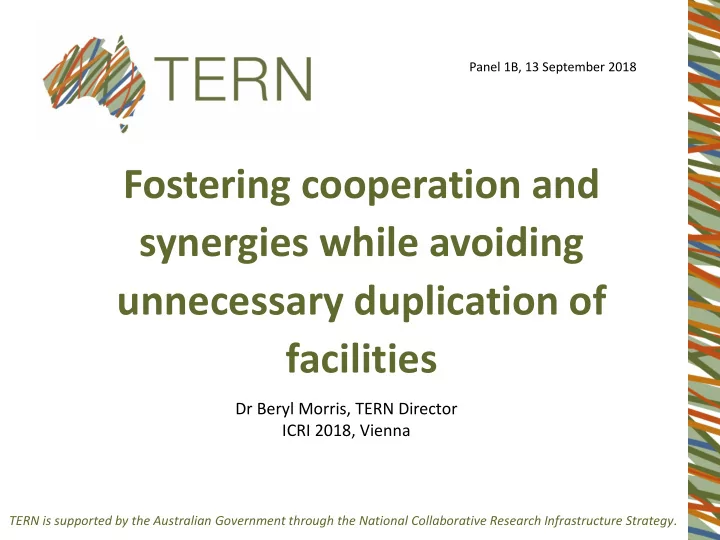

Panel 1B, 13 September 2018 Fostering cooperation and synergies while avoiding unnecessary duplication of facilities Dr Beryl Morris, TERN Director ICRI 2018, Vienna TERN is supported by the Australian Government through the National Collaborative Research Infrastructure Strategy .
Global RI cooperation: biodiversity loss o Biodiversity loss substantially diminishes several ecosystem services by altering ecosystem functioning and stability, especially at the large temporal and spatial scales that are most relevant for policy and conservation.
Global RI cooperation: biodiversity loss At the global spatial scale over decades or centuries, the ever-increasing and unprecedented extent and impact of human activities on land and in the oceans is dramatically reducing global biodiversity
Fostering cooperation in building global RI Not all problems have a technological solution “Tragedy of the Commons” Information Information infrastructure is a socio-technical System Trust and requiring integrated socio- Discover understand Finding data technical design Using data and services Semantic Institutions Definitions Legislation, regulation, Machines working governance and with machines incentives Interoperability Technical Social Agreements Policy, standards, Access Social systems involved licensing and IP Using services Economics the conscious design of an Social Digital economics, funding Culture, ethics , & business models attitudes, behaviour environment that encourages a desired range of behaviours leading towards some goals https://research.csiro.au/oznome/
Global organisations: biodiversity targets and measures For example…
Social infrastructure: Tanami Indigenous cooperation o Data on the biodiversity of more than 10 million hectares of land in central Australia are now openly available to the world via TERN RI. o Collected by Indigenous rangers and traditional owners in collaboration with the mining industry, land council and environmental consultancy partners with TERN protocols o The data is being used to assess the spatial and temporal trends in the occurrence of threatened species, and the impacts of mining on the region's flora and fauna
Timing, capability and circumstances are important for fostering cooperation
A national integrated environmental prediction system (NEPS) PRINCIPLES • ADOPT – ADAPT – (INVENT) : Construct the NEPS through networking of existing infrastructure, where possible • ENHANCE – ACCELERATE : Invest in the strengthening of existing national research infrastructure elements to enhance their accelerating abilities in inter-operability • USER – CENTRED : Grow the NEPS by prioritising early developments in innovative, valued information products for users • COLLABORATIVE : Prepare for medium-term integration with relevant environmental information systems outside the government’s national research infrastructure, such as the ACCESS model and Data Integration Partnerships for Australia • INTEGRATED : Plan for inter-operability with economic and social system models
Fostering cooperation and synergies while avoiding unnecessary duplication of facilities NEPS: using what we have through partnerships…
Fostering cooperation Challenge is to harmonise our existing Networks and to formalise Global Environmental RIs Aim is to achieve an international, comprehensive, integrated, and sustained Global Environmental observation system that provides the tools and data to help “take the pulse of the planet”
Recommend
More recommend